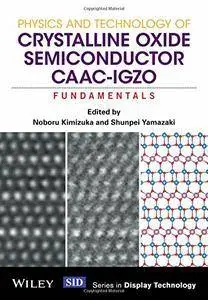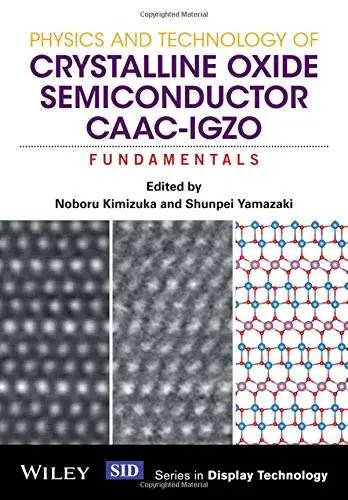Physics and Technology of Crystalline Oxide Semiconductor CAAC-IGZO: Fundamentals
Wiley | Semiconductors | Oct. 17 2016 | ISBN-10: 1119247403 | 344 pages | pdf | 31.45 mb
Wiley | Semiconductors | Oct. 17 2016 | ISBN-10: 1119247403 | 344 pages | pdf | 31.45 mb
by Noboru Kimizuka (Author), Shunpei Yamazaki (Author)
Electronic devices based on oxide semiconductors are the focus of much attention, with crystalline materials generating huge commercial success. Indium–gallium–zinc oxide (IGZO) transistors have a higher mobility than amorphous silicon transistors, and an extremely low off-state current. C-axis aligned crystalline (CAAC) IGZO enables aggressive down-scaling, high reliability, and process simplification of transistors in displays and LSI devices. This original book introduces the CAAC-IGZO structure, and describes the physics and technology of this new class of oxide materials. It explains the crystallographic classification and characteristics of crystalline oxide semiconductors, their crystallographic characteristics and physical properties, and how this unique material has made a major contribution to the field of oxide semiconductor thin films. Two further books in this series describe applications of CAAC-IGZO in flat-panel displays and LSI devices.
Key features:
• Introduces the unique and revolutionary, yet relatively unknown crystalline oxide semiconductor CAAC-IGZO • Presents crystallographic overviews of IGZO and related compounds.
• Offers an in-depth understanding of CAAC-IGZO.
• Explains the fabrication method of CAAC-IGZO thin films.
• Presents the physical properties and latest data to support high-reliability crystalline IGZO based on hands-on experience.
• Describes the manufacturing process the CAAC-IGZO transistors and introduces the device application using CAAC-IGZO.
About the Author
Shunpei Yamazaki, Semiconductor Energy Laboratory Co., Ltd., Kanagawa, JAPAN
Dr. Shunpei Yamazaki is an authority on semiconductors, memory devices, and liquid crystal displays. Listed on over 4,000 US utility patents, Dr. Yamazaki was named in the Guinness Book of World Records as holding the most patents in the world; hailed the most prolific inventor in history by USA Today (in 2005). His most notable work is on the thin-film transistor – a significant discovery being a crystalline structure in Indium gallium zinc oxide (IGZO) material, which he discovered "by chance" in 2009. Today Dr. Yamazaki is President of the Semiconductor Energy Laboratory (SEL), where he and his team pioneered the unique development of ultra-low-power devices using CAAC-IGZO technology. A joint venture with the Sharp Corporation manufacturing smartphones using crystalline oxide semiconductors (IGZO) is a global first. In 2015 Dr. Yamazaki received the SID (Society for Information Display) Special Recognition Award for "discovering CAAC-IGZO semiconductors, leading its practical application, and paving the way to next-generation displays." His paper on CAAC-IGZO ranked in the top 15 most downloaded papers of Wiley Electrical Engineering and Communications Technology journals, 2014. Dr. Yamazaki is also an IEEE Life Fellow.
Noboru Kimizuka, Kimizuka Institute for Natural Philosophy, Poland
Noboru Kimizuka: director of Kimizuka Institute for Natural Philosophy in Poland and adviser of Semiconductor Energy Laboratory, Co., Ltd. He received a Doctor of Science degree from Tokyo Institute of Technology. He joined in the National Institute for Research in Inorganic Materials (NIRIM) of Science and Technology Agency in 1967 (The institute later became the National Institute for Materials Science.) In 1985, he synthesized crystalline IGZO for the first time in the world at NIRIM. Since then, he devoted himself for developing homologous IGZO for about ten years. After he left NIRIM, he served as a researcher and a visiting professor, teaching young people at universities in the U.S., Britain, Mexico, Taiwan, South Korea, and Japan. He is a member of the Chemical Society of Japan, the Ceramic Society of Japan, the Physical Society of Japan, and American Ceramic Society.
Topics
Physics
Engineering
Click Here for More books



